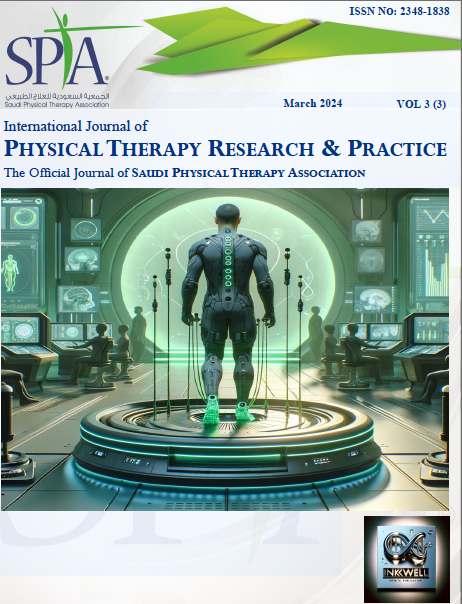Enhancing Postural Stability in Patients with Diabetic Peripheral Neuropathy: Assessing the Impact of Vestibulo-Postural Training Using a Bipodalic Stabilometric Platform
DOI:
https://doi.org/10.62464/ijoprp.v3i3.15Keywords:
Diabetic peripheral neuropathy, Prokin 252, Proprioceptive Balance training, Stabilometric PlatformAbstract
Aims & Objective: The aim of this study is to evaluate the effectiveness of Vestibulo-Postural Training Using a Bipodalic Stabilometric Platform in patients with diabetic peripheral neuropathy. Methodology: Thirty-two participants were randomly allocated into either Level Bipodalic Stabilometric Training Group (LBSTG) or Tilted Bipodalic Stabilometric Training Group (TBSTG), using a computer-generated randomization sequence. The study's approach to evaluating postural control in individuals with Diabetic Peripheral Neuropathy (DPN) involved a precise methodology using a state-of-the-art ProKin 252 balancing platform (ProKin 252, TecnoBody, Italy). Results: The study revealed that while the LBSTG training did not produce a significant change in postural control for individuals with DPN, the TBSTG training led to a significant improvement. These results highlight the potential benefits of incorporating challenging balance tasks into rehabilitation programs for individuals with DPN to enhance postural control and stability. Conclusions: this study advocates for the importance of innovative balance training interventions in enhancing the stability and mobility of patients with DPN, potentially leading to improved clinical outcomes in the management of this condition.
References
Akbari, M., Jafari, H., Moshashaee, A., & Forugh, B. (2012). Do diabetic neuropathy patients benefit from balance training? Journal of Rehabilitation Research and Development, 49(2), 333-338. https://doi.org/10.1682/JRRD.2010.10.0197
Allet, L., Armand, S., de Bie, R. A., Golay, A., Monnin, D., Aminian, K., Staal, J. B., & de Bruin, E. D. (2010). The gait and balance of patients with diabetes can be improved: A randomised controlled trial. Diabetologia, 53(3), 458-466. https://doi.org/10.1007/s00125-009-1592-4
Alonso-Enríquez, L., Gómez-Cuaresma, L., Billot, M., Garcia-Bernal, M. I., Benitez-Lugo, M. L., Casuso-Holgado, M. J., & Luque-Moreno, C. (2023). Effectiveness of Virtual Reality and Feedback to Improve Gait and Balance in Patients with Diabetic Peripheral Neuropathies: Systematic Review and Meta-Analysis. Healthcare, 11(23), 3037. https://doi.org/10.3390/healthcare11233037
Cuesta-Vargas, A. I., & González-Sánchez, M. (2013). Differences in muscle activation patterns during sit to stand task among subjects with and without intellectual disability. Biomed Research International, 2013, 173148. https://doi.org/10.1155/2013/173148
Eftekhar-Sadat, B., Azizi, R., Aliasgharzadeh, A., Toopchizadeh, V., & Ghojazadeh, M. (2015). Effect of balance training with Biodex Stability System on balance in diabetic neuropathy. Therapeutic Advances in Endocrinology and Metabolism, 6(5), 233-240. https://doi.org/10.1177/2042018815595566
Grewal, G. S., Schwenk, M., Lee-Eng, J., Parvaneh, S., Bharara, M., Menzies, R. A., Talal, T. K., Armstrong, D. G., & Najafi, B. (2015). Sensor-Based Interactive Balance Training with Visual Joint Movement Feedback for Improving Postural Stability in Diabetics with Peripheral Neuropathy: A Randomized Controlled Trial. Gerontology, 61(6), 567-574. https://doi.org/10.1159/000371846
Iram, H., Kashif, M., Hassan, H. M. J., Bunyad, S., & Asghar, S. (2021). Effects of proprioception training programme on balance among patients with diabetic neuropathy: A quasi-experimental trial. Journal of the Pakistan Medical Association, 71(7), 1818-1821. https://doi.org/10.47391/JPMA.286
Kharroubi, A. T., & Darwish, H. M. (2015). Diabetes mellitus: The epidemic of the century. World Journal of Diabetes, 6(6), 850-867. https://doi.org/10.4239/wjd.v6.i6.850
Kruse, R. L., Lemaster, J. W., & Madsen, R. W. (2010). Fall and balance outcomes after an intervention to promote leg strength, balance, and walking in people with diabetic peripheral neuropathy: "Feet First" randomized controlled trial. Physical Therapy, 90(11), 1568-1579. https://doi.org/10.2522/ptj.20090362
Lee, K., Lee, S., & Song, C. (2013). Whole-body vibration training improves balance, muscle strength and glycosylated hemoglobin in elderly patients with diabetic neuropathy. Tohoku Journal of Experimental Medicine, 231(4), 305-314. https://doi.org/10.1620/tjem.231.305
Mao, W., Wang, T., Sun, M., Zhang, F., & Li, L. (2023). Effects of Tai Chi on Postural Control in People with Peripheral Neuropathy: A Systematic Review with Meta-Analysis. Healthcare, 11, 1559. https://doi.org/10.3390/healthcare11111559
Nomura, T., Kawae, T., Kataoka, H., & Ikeda, Y. (2018). Aging, physical activity, and diabetic complications related to loss of muscle strength in patients with type 2 diabetes. Physical Therapy Research, 21(2), 33-38.
Nomura, T., Kawae, T., Kataoka, H., & Ikeda, Y. (2021). Loss of lower extremity muscle strength based on diabetic polyneuropathy in older patients with type 2 diabetes: Multicenter Survey of the Isometric Lower Extremity Strength in Type 2 Diabetes: Phase 2 study. Journal of Diabetes Investigation, 12(3), 390-397. https://doi.org/10.1111/jdi.13403
Shaik, A. R., Ahmad, F., Miraj, M., Alqahtani, M., Alzhrani, M., Alanazi, A., & Kashoo, F. (2021). Efficacy of the structured balance awareness program on perceived balance confidence and fear-related maladaptive behaviour in post-stroke survivors. NeuroRehabilitation, 49(4), 547-552. https://doi.org/10.3233/NRE-210144
Wüest, S., Borghese, N. A., Pirovano, M., Mainetti, R., van de Langenberg, R., & de Bruin, E. D. (2014). Usability and Effects of an Exergame-Based Balance Training Program. Games for Health Journal, 3(2), 106-114. https://doi.org/10.1089/g4h.2013.0093

Downloads
Published
Versions
- 2024-03-20 (3)
- 2024-03-20 (2)
- 2024-03-20 (1)
Issue
Section
License
Copyright (c) 2024 International Journal of Physical Therapy Research & Practice

This work is licensed under a Creative Commons Attribution-NonCommercial-NoDerivatives 4.0 International License.



